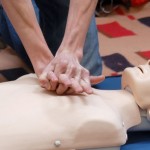Whether for work, personal knowledge, or school, CPR (Cardiopulmonary Resuscitation) Training is necessary to save a person’s life. No matter if it’s a part of your job or not, CPR or first aid certification is an important skill to acquire. Professionals like fitness instructors, teachers, and lifeguards must require CPR certification. This life-saving technique helps maintain blood flow to the heart and brain during life-threatening emergencies like stroke or cardiac arrest. With proper knowledge in CPR and providing immediate medical attention, there are increased chances of survival. This entails the importance of CPR training and investing your time in getting a CPR and First-Aid Certification would be vastly beneficial.
To become certified in CPR, you’ll need to attend formal training and pass a written exam. You’ll have to exhibit that you can perform CPR or first aid understanding the requirements of the technique.
Now, if you have decided to get your CPR certification online, you have lots of options. Two organizations: the American Heart Association (AHA) and the Red Cross will come up while you search for the best CPR classes online. These are the two most popular and widely recognized organizations for CPR training.
AHA & ARC- Most Renowned CPR Training Providers
American Heart Association (AHA) is a research organization responsible for research as well as establishing the guidelines for CPR training which are widely accepted and used throughout the country. It also promotes the learning of CPR through its research. The American Red Cross, on the other hand, promotes and offers CPR training based on the latest guidelines and research.
Both the American Red Cross (ARC) and American Heart Association (AHA) are reputed organizations that offer best-in-class CRP training programs online for healthcare providers, corporate, students, and individuals of other prospects.
Types of Courses Offered by AHA & ARC
Both ARC and AHA offer courses ranging from basic first aid and CPR to offerings for healthcare professionals like ALS (Advanced Life Support), PALS (Pediatric Advanced Life Support), and BLS (Basic Life Support). They provide CPR classes online at varying levels beneficial for laypersons and community members, healthcare personnel, corporate CPR training, and others. Find the specific courses offered by these organizations below.
Courses Offered by ARC:
- CPR for Schools and the Community: Teaches students on how to administer hands-only CPR.
- CPR for Professional Rescuer: CPR classes for students on how to respond to breathing and cardiac emergencies in infants, children, and adults.
- CPR for the Workplace: Enables small or large groups of individuals to receive CPR training. It allows employers to educate their employees about CPR and create safer work environments.
AHA CPR Certification Courses:
- Basic Life Support (BLS) for Healthcare Providers: For individuals in the healthcare industry like pharmacists, registered nurses, and other medical professionals. The course focuses on administering adult, child, and infant CPR, assisting conscious and unconscious choking victims, the importance of the breathing barrier, and more.
- Heartsaver CPR AED: Ideal for lay people of all ages and skill levels. It helps individuals learn the technique of providing CPR to adults, children and infants. Teachers, babysitters, physical therapists, and others can take this course.
Heartsaver CPR, AED, and First Aid, Family & Friends CPR, CPR Anytime (Adult or Adult & Child), and Hands-only CPR, Pediatric Advanced Life Support (PALS), and Heartcode Advanced Cardiovascular Life Support (ACLS) are other CPR training courses offered by AHA.
Note that CPR courses and training offered by AHA are more in-depth because they research on the proper CPR guidelines.
Before moving on to decide which CPR certification is best, let us know the key similarities and differences between the two-AHA and ARC.
Similarities
In general, the American Heart Association and the American Red Cross are most probably equivalent in terms of courses offered and learning techniques. Both are accepted at many healthcare facilities and hospitals. Some of the key similarities include:
Both AHA and ARC organizations offer traditional classroom CPR training, CPR online classes, and blended learning options, like in-person courses. CPR non-certification courses for laypersons can be taken online entirely. However, if you are looking for a CPR certification, you’ll need to undertake skills testing and evaluate with a licensed instructor online. Other similarities include:
Both AHA and ARC use guidelines for CPR training as established by the AHA. While AHA sets up the guidelines, ARC adheres and teaches its principles.
- Both offer CPR First Aid Certifications and CPR/AED Certifications to healthcare professionals as well as laypeople.
Differences between the AHA & the ARC CPR Certifications
There are few variations between AHA and CPR Certifications, and the differences are based on various factors like Course Structure, Certification & Class Length, Price, Difficulty Level, and Certification Acceptance. Refer to the table below.
| Differences | ||
| Components | AHA (American Heart Association) | ARC (American Red Cross) |
| Background | Researches and provides CPR guidelines. | Use guidelines established by AHA. |
| Course Structure | More in-depth and practice-oriented courses. Has a varied fee structure. You have to pay for three things separately on taking a blended-learning, certification focused CPR class: The Online Course, The Skills Check, & The Manual). | Everything, including the manual and skills, is covered in the up-front price. You can either undertake the entire course or a skills test. |
| Certification Length | 2-year certification; AHA is the best choice for a standard CPR certification for laypersons. | Good for one or two years, depending on the level of CPR Certification. |
| Class Length | AHA CPR classes are shorter, usually. | Were significantly longer than AHA (Now, the same length as AHA) |
| Price | Slightly less expensive than ARC and vary significantly since private companies handle the classes. | Excellent skills reference guide with the class price. |
| Difficulty Level | More extensive and more challenging. Requires a passing score of 84% or higher. | A passing score of 80% or higher in the final exam would be sufficient. |
| Certification Acceptance | More widely known and accepted by healthcare professionals and the AHA certifications lasts longer- for 2 years followed by CPR renewal. | Most ARC courses are valid only for a single year, except the health provider course. |
Now that you understand the similarities and differences between AHA and ARC CPR courses, are you wondering which would be your best choice? Well, here we help you with that, too. We recommend you to decide on the CPR certification course based on your objective and requirements.
An organization’s CPR classes may better fit your requirements and meet your goals than the others. For instance, AHA CPR Certification would be best for healthcare professionals as many hospitals and healthcare centers widely accept them. Ask yourselves the below questions before signing up for a course.
- What is your objective, and what does your workplace require?
- Which courses are currently available?
- What CPR classes are near my place?
- Will your employer or school accept the course?
Answer these questions before you sign up for a CPR certification course.
Conclusion
With CPR classes becoming a necessity, taking the perfect CPR course that suits your requirements would benefit you. Both the American Heart Association and American Red Cross are exceptionally good organizations that offer equally good CRP courses. Both are accepted at many workplaces, hospitals, or schools. Just check with your employer before taking a CPR course, and you should be able to choose the one that’s ideal for you.
CPR Courses & First Aid Training & Certifications
Adult-Child-Infant CPR/AED & First Aid Training
Adult CPR/AED & Standard First Aid Training
Adult-Child-Infant CPR/AED Training
Online Adult, Child, Infant CPR Classes & First Aid Training
Online First Aid Course & Certification
CPR Online Classes
BLC CPR Certification Online
Online First Aid Course & CPR Certification Canada
Check out our other CPR & First Aid Related Articles:
INFANT CPR CERTIFICATION & ITS IMPORTANCE
THE IMPORTANCE OF TAKING BLS TRAINING
WHAT IS THE DIFFERENCE BETWEEN CPR AND AED TRAINING?
WHEN TO USE A MANUAL OR AUTOMATIC EXTERNAL DEFIBRILLATOR
10 THINGS YOU DIDN’T KNOW ABOUT CPR



